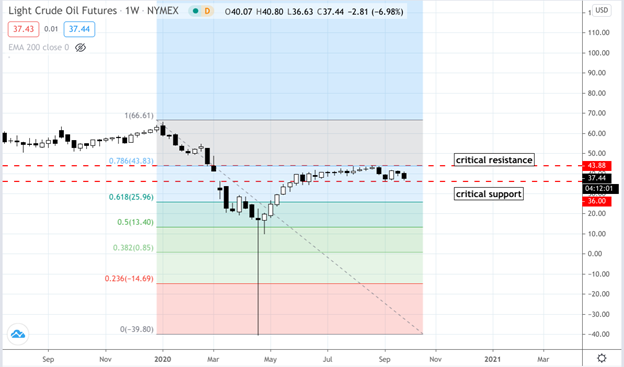Countries across the globe are struggling in the face of the COVID-19 pandemic. Oil-producing nations that are part of OPEC+ are no exception. Russia is one of these countries and the news out of the former Soviet Union is that they expect the road to recovery for one of their biggest exports to be long and arduous.
The pandemic has hurt oil demand around the globe in a big way. Quarantines, work-at-home orders, and measures to flatten the curve have slowed or halted everything from daily commutes to holiday travel to factory production. The demand for energy is nowhere near where it was at this time last year, down around 10%.
The heads of the Russian oil industry, including the country’s Energy Minister, believe that the recovery for oil demand will be a slow process in the coming months. The energy sector head recently told fellow G-20 energy ministers that he believes it will “take quite a while” to get back to pre-pandemic demand.
The oil market has come back somewhat from the height of the pandemic but that upward trajectory has stalled somewhat, well before it reached 2019 or projected 2020 levels. Oil demand in the U.S. and some major oil-consuming parts of Europe is still muted as these countries have yet to fully manage COVID’s spread.
The lack of demand is only one side of the problem. On the supply side, oil production is currently too high. Iraq is currently exporting much more oil than expected and Libya’s waning civil war has led to an increase in their production as well.
This increased supply should only serve to hurt the oil market and drive prices even further down. Leading oil industry experts around the world are predicting that even conservative demand forecasts for the rest of the year are much more likely to be revised down than exceed expectations. This is on top of the International Energy Agency already dropping their projections by almost half a million barrels a day in the last 2 months.
As a member of OPEC+, Russia is trying to do its part to help balance the supply side with the lower demand. Their oil industry leadership has said that they are leading the way within the sector to help keep the oil market as stable as possible and prevent a crash.
For their part, OPEC+ has echoed Russian sentiment and has threatened to take drastic action to balance the market if the need arises. In a statement from the organization’s governing body, they promised to be “proactive and preemptive” with their supply mandates and possible production cut orders.
Russia is just one of the countries that sees a long road back on the demand side of the oil market. Recent coronavirus spikes in New York and parts of Europe that seemingly had the virus under control show how fragile the oil demand is. And, many leading experts around the globe believe it could be up to 18 months before the demand rebounds to where it needs to be for oil-producing nations like Russia to feel the recovery.
Crude Oil Futures – Weekly Chart – July 22, 2019 to October 2, 2020 (Source: Tradingview)

On the technical side of things, one can argue that the current levels represent a 78.6% bear rally retracement. Typically, beyond the 70% retracement level, the dominant trend may be rendered questionable. So, technically, a break above critical resistance of $43.88 per barrel would signal a bullish reversal of the longer-term downtrend. A break below critical support of $36.00 would represent further downside, a continuation of the bearish trend.
The fundamental picture can be interpreted as not looking very promising in the near-term. Until the global economy is able to contain the spread of COVID-19, the economic outlook, particularly for oil, remains highly uncertain.
Please be aware that the content of this blog is based upon the opinions and research of GFF Brokers and its staff and should not be treated as trade recommendations. There is a substantial risk of loss in trading futures, options and forex. Past performance is not necessarily indicative of future results.
Disclaimer Regarding Hypothetical Performance Results: HYPOTHETICAL PERFORMANCE RESULTS HAVE MANY INHERENT LIMITATIONS, SOME OF WHICH ARE DESCRIBED BELOW. NO REPRESENTATION IS BEING MADE THAT ANY ACCOUNT WILL OR IS LIKELY TO ACHIEVE PROFITS OR LOSSES SIMILAR TO THOSE SHOWN. IN FACT, THERE ARE FREQUENTLY SHARP DIFFERENCES BETWEEN HYPOTHETICAL PERFORMANCE RESULTS AND THE ACTUAL RESULTS SUBSEQUENTLY ACHIEVED BY ANY PARTICULAR TRADING PROGRAM.
ONE OF THE LIMITATIONS OF HYPOTHETICAL PERFORMANCE RESULTS IS THAT THEY ARE GENERALLY PREPARED WITH THE BENEFIT OF HINDSIGHT. IN ADDITION, HYPOTHETICAL TRADING DOES NOT INVOLVE FINANCIAL RISK, AND NO HYPOTHETICAL TRADING RECORD CAN COMPLETELY ACCOUNT FOR THE IMPACT OF FINANCIAL RISK IN ACTUAL TRADING. FOR EXAMPLE, THE ABILITY TO WITHSTAND LOSSES OR TO ADHERE TO A PARTICULAR TRADING PROGRAM IN SPITE OF TRADING LOSSES ARE MATERIAL POINTS WHICH CAN ALSO ADVERSELY AFFECT ACTUAL TRADING RESULTS. THERE ARE NUMEROUS OTHER FACTORS RELATED TO THE MARKETS IN GENERAL OR TO THE IMPLEMENTATION OF ANY SPECIFIC TRADING PROGRAM WHICH CANNOT BE FULLY ACCOUNTED FOR IN THE PREPARATION OF HYPOTHETICAL PERFORMANCE RESULTS AND ALL OF WHICH CAN ADVERSELY AFFECT ACTUAL TRADING RESULTS.